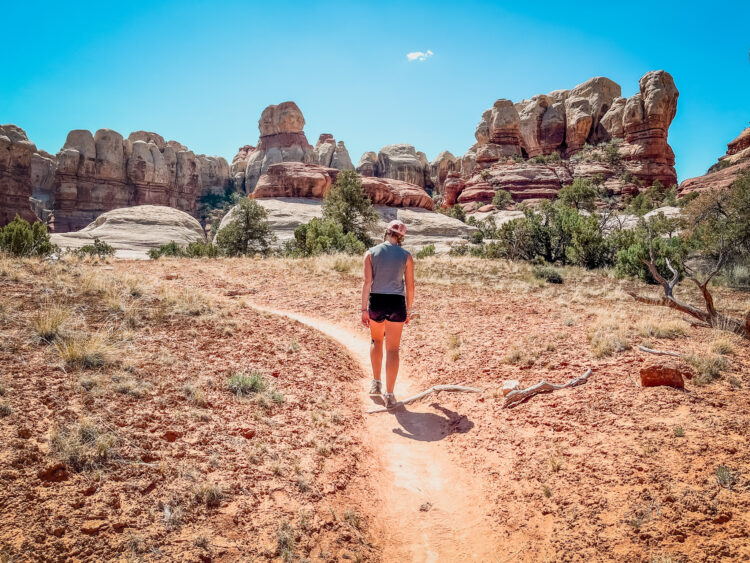Whether you are planning to get out on the trail for some winter hiking or just want to walk down the street in the winter without sliding all over the place, a good pair of microspikes will make a huge difference. Enjoy winter this year with the best microspikes for hiking, walking, and running.
Living in NH, our family uses our microspikes often over the winter. We’ve tried many different kinds over the years and have suggestions below for microspikes for the whole family for whatever activity your doing.
As an Amazon Affiliate I receive compensation when you purchase through a link on this page
Quick Look at the Best Microspikes for Hiking, Walking, and Running
Microspikes | Best For | Cost | Check Prices | |
Winter hiking, backpacking, ice-trekking, ice fishing and trail-running | $$ | |||
Winter Hiking and backpacking | $$ | |||
Winter running, walking, and hiking | $$$ | |||
Winter Walking, Running, and light hiking | $ | |||
Winter walking and hiking | $ | |||
Mountaineering hiking with elevation | $$$$ | |||
Best for kids, winter hiking and walking | $ |
What are Microspikes?
Microspikes are chains and small spikes that are attached to the bottom of boots or shoes to improve traction in the winter. They are specifically useful if you are walking on ice: such as winter hiking, running, walking, fishing, and clearing snow. Choosing the best Microspikes for hiking or other winter activities means assessing the quality of the item as well at your intended use.
Microspikes vs Yaktrax
Microspikes generally have small spikes that attach to the bottom of boots or shoes, while Yaktrax use metal pieces to dig into the ice. I’ve included both items on the list as they both work well in icy conditions. Typically Yaktrax are less expensive and are better when the ice is softer or you are hiking in flat conditions.
Microspikes Versus Crampons
Microspikes have small spikes while crampons have larger spikes and true crampons have the front spikes angled forward on the toe. This allows you to use crampons to dig into hard ice when you are climbing uphill. You can see one true crampon on the list below. You will often see microspikes called crampons but look at the length of the spike.
Learn more about: Crampons vs Microspikes vs Snowshoes: A Complete Guide for What to Wear Winter Hiking
Microspikes versus Snowshoes
If you will be using your microspikes mostly for hiking, you may want to consider snowshoes. Most snowshoes have crampons surrounded by the snowshoe to keep you above the snow. Snowshoes are better if you will be hiking in deep snow. Microspikes work best when you hike on icy conditions or hard packed snow. We often use our microspikes even when there isn’t snow.

The Best Microspikes for Hiking, Walking, and Running
Kahtoola MICROspikes
These microspikes are great for many purposes and are the best all-around spikes. They have more traction compared to Yaktracks so dig in better to the ice. They are great for hiking and even just shoveling your driveway.
They are easy to put on and have 5 sets of spikes, making them more versatile. These fit different boots well and the stainless steel spikes are built for durability.
Hillsong Trail Crampon
These are called crampons but are much closer to microspikes with small spikes that sit on the bottom of the boot (see more below for microspikes vs. crampons). These are very sturdy and come with a 2 year warranty.
They are very durable and since they are more like a small crampon, they are best used on trails as opposed to a driveway or road walk. They could also be used for trail running in the winter.
Black Diamond Distance Spike
These microspikes are excellent for running, walking, and hiking. They easily fit on sneakers and hiking boots. They are built to last and since the metal attaches to a softshell toe cover and heel retention elastomer they are extra durable.
These are a better option if you are mostly going to be running or walking and don’t need longer spikes or crampons for hiking. They are also only 6.7 ounces and have a small bag for easy storage.
Yaktrax Diamond Grip All-Surface Traction Cleats
These Yaktrax work differently than microspikes since they don’t rely on the small spikes to dig into the ice. Instead, they use a series of strung diamond grips that dig into the ice. We have several pairs of these are our house and find that they work surprisingly well on the ice.
They are best on flatter surfaces as they don’t dig deep into the ice like a pair of crampons of more jagged microspikes. They are also light and easy to put into a bag.
Dream 28 Crampons Ice Cleats
These are inexpensive microspikes that are perfect for use around the home and hiking. Dave has used these microspikes for a few years and they do well on most hikes and trail walks.
There are a lot of spikes on the bottom of these spikes and the strap that goes across the top of the foot helps to keep the microspikes in place. These are a great option for the price!
Petzl – VASAK, Crampons
Unlike the microspikes listed above, these are true crampons and are best used for mountaineering and more serious hiking where you need to grip into the ice. The major difference is the length of the spikes and the position of the spikes on the toe that let you dig into the ice on a slope.
These are not the best choice for flat hikes or for clearing the driveway as they can be difficult to walk in in these conditions.
LINXGR 11-Spikes Kids Crampons Ice Cleats
These microspikes are designed specifically for kids and are made to fit smaller boot sizes. My youngest used and they worked well for both flat walks and winter hikes. They do have sharp spikes on the bottom so even though they are sized down to toddlers, I would only use them for walks and not when kids are playing as they are sharp.
These microspikes for kids are well made and high quality for the price.
Sizing Microspikes
The sizing differs by each company, and you should read the individual sizing charts. You will usually see small, medium, large, etc. These sizes are based on the size of the shoe or boot you will put the microspikes onto. You want to try to get the sizing right, as if you get your micrspikes too small you will find it difficult to quickly and easily put them on. On the other hand, if they are too big they will easily fall off when you’re hiking.
What to Consider When Looking for the Best Microspikes for Hiking, Walking and Running
Spike Length
As you can see, the words microspikes, ice cleats, and crampons are often used interchangeably. These different styles have a variety of teeth, chains and cleats that dig into the ice. Chains and cleats are more comfortable to hike in, but don’t dig into the ice as deeply, meaning they work better on flat surfaces. Small spikes are the most versatile and are the overall best microspike for hiking.
I have not included any of the cleat style microspikes on the list as I’ve only used them once and found they didn’t work well for hiking. They would likely be a good option for walking on ice roads with a thin layer of ice (where spikes don’t work well)The spike length you will need for your microspikes will depend on the terrain you will be hiking in. If you are hiking on flat trails, you can use smaller spikes. If you are hiking on more technical trails, you will need larger spikes to provide additional traction.

Durability
Finding microspikes that don’t break is another important thing to consider. Since your microspikes with be undergoing strain under cold temperatures, the breaking point temperature of the elastic is helpful to know. Most microspikes have a low break point, but if you buy one of the cheaper options, you will be best off using them at extremely cold temperatures.
Most of the best microspikes for hiking have hard treated metal. These should last longer and not bend or rust. If you are walking where there is a lot of salted roads you should give your microspikes a quick rinse to avoid rusting.
We’ve found the weakest part of the microspikes is often where the metal pieces attach to the plastic shoe grip. Putting the microspikes on properly will help limit the rubbing in these place and make them last longer.
How Easy They are to Use
You should be able to put the microspikes onto your shoe or boot in just a minute without taking off your glove. You should avoid spikes with too many straps that need adjusting. The easiest microspikes to use have a rubber body that can easily be stretched over the boot in one pull.
Weight and Packability
If you are planning to hike with your microspikes, you will likely not wear them the entire distance. This means that you will need to carry them. We’ve had many winter hikes where we never wear them and just carry them for the whole hike. If you are trying to decide between two different microspikes and have already considered durability, ease of use, and the type of spikes, you should choose the lightest microspikes.
Many microspikes come with their own bag and this is a nice addition if you will be carrying them on lots of hikes.
Common Questions about Microspikes How effective are microspikes? Microspikes are effective at giving increased traction when walk on ice or hard packed snow. If you are hiking with extreme elevation gain, you may want to consider crampons instead of microspikes. Microspikes are a good choice to walking, running, hiking, and clearing snow. Can you walk on rocks with microspikes? You can walk on rock with microspikes and they can be especially helpful when the snow is icy and slippery. On straight up rock, use caution and be aware that the rocks can cause the microspikes to wear prematurely. When you are using the best microspikes for hiking, you will inevitably walk on rock at some point. What shoes to wear with microspikes? Microspikes attach well to most hiking, winter boots, and sneakers. You will need to buy the correct size microspikes. If you will be wearing them mostly with winter boots, you may want to go up one size.
Do you have a favorite pair of microspikes I didn’t include? Leave a comment below and I’ll update the best microspikes for hiking, running and walking.
Looking for more Gear Guides? Visit our: Best Adventure and Travel Gear
Are you new to winter hiking? See our guide: Winter Hiking for Beginners



















